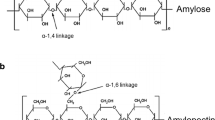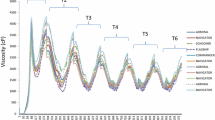Abstract
Potatoes of two cultivars representing extremes in potato texture, Russet Burbank (mealy) and IdaRose (waxy), were lyophilized, ground into flour, and analyzed with a Rapid Visco Analyzer (RVA) to identify flour pasting characteristics unique to each cultivar. A factorial experiment, which included multiple levels of heating rate, peak temperature, and flour concentration, was employed to assess RVA run parameter association with flour pasting behaviors and the potential to differentiate cultivars according to the responses. Pasting profiles of the potato flour provided a unique functional finger-print for each cultivar flour, which embodies structural and molecular components of the native potato tissue. Pasting profile viscosity attributes were influenced by variable levels of heating rate, peak temperature, and flour concentration. At increasing flour concentrations, RVA viscosity attributes increased in magnitude, but possessed similar pasting curves. A variable heating rate primarily affected events occurring early within the pasting profile (time to gelatinization, time to peak viscosity, peak viscosity), while changes in peak temperature influenced viscosity attributes (trough viscosity, breakdown, final viscosity, total setback) associated with the latter portion of the viscosity curve. A high peak temperature generally resulted in increased breakdown and total setback and decreased trough and final viscosities. RVA viscosity attributes, time to gelatinization, peak viscosity, breakdown, and final viscosity were identified as potential characteristics for cultivar differentiation. Discrimination of the cultivar extremes was affected by RVA run parameters, and was maximized at moderate heating rates (4 to 6 C min-1), moderate to high levels of peak temperature (85 to 90 C), and intermediate flour concentrations.
Resumen
Papas de dos cultivares que representan condiciones extremas, Russet burbank (harinoso) e IdaRose (ceroso) fueron liofilizadas, molidas hasta convertirlos en harina y analizadas con un Analizador Visco Rapid (RVA) para identificar las características específicas de la masa prroveniente de la harina de cada cultivar. Un experimento factorial, el cual incluyó niveles múltiples de la tasa de calor, temperatura máxima y concentración de harina se utilizó para determinar la asociación del parámetro de la masa y su potencial para diferenciar los cultivares de acuerdo a las respuestas. Los perfiles de la masa proporcionaron un patrón único de bandas, funcional para la harina de cada cultivar, lo cual incluye a los componentes estructurales y moleculares del tejido natural de la papa. Los atributos de viscosidad del perfil de la masa fueron influenciados por los niveles variables de la tasa de calentamiento, temperatura máxima y concentración de la harina. Al incrementarse la concentración de harina las cualidades de viscosidad RVA aumentaron en magnitud, pero presentaron curvas similares en la masa. Una tasa variable de calentamiento afectó principalmente los eventos que ocurren inicialmente en el perfil de amasado (tiempo para la gelatinización, tiempo para la máxima viscosidad, máxima viscosiedad), mientras que los cambios en la temperatura máxima ejercieron influencia sobre los atributos de viscosidad (viscosidad inicial, deterioro, viscosidad final, retroceso total), asociados con la última porción de la curva de viscosidad. Una temperatura máxima generalmente resultó en el aumento del deterioro y retroceso total y disminuyó la viscosidad inicial y final. Los atributos de viscosidad RVA, tiempo de gelatinización, viscosidad máxima, deterioro y viscosidad final fueron identificados como características potenciales para la diferenciación de cultivares. La discriminación de los extremos del cultivar fue afectada por los parámetros RVA corridos, y llegó al máximo con tasas moderadas de calentamiento (4 a 6 C min-1), moderados a altos niveles de temperatura máxima (85 a 90 C) y concentraciones intermedias de harina.
Similar content being viewed by others
Abbreviations
- RVA:
-
Rapid Visco Analyzer
- RB:
-
Russet Burbank
- IR:
-
IdaRose
Literature Cited
AACC (American Association of Cereal Chemists) 2000. Approved methods of the AACC, 10th ed. American Association of Cereal Chemists, St. Paul, MN.
AOAC (Association of Official Analytical Chemists) 1990. Official methods of analysis of AOAC international, 16th ed. AOAC International, Arlington, VA.
Agblor A, and MG Scanlon. 1998. Effects of blanching conditions on the mechanical properties of french fry strips. Am J Potato Res 75:245–255.
Alvarez MD, and W Canet. 1998. Rheological characterization of fresh and cooked potato tissues (cv. Monalisa). Z Lebensm Unters Forsch A 207:55–65.
Alvarez MD, and W Canet. 1999. Optimization of stepwise blanching of frozen-thawed potato tissues (cv. Monalisa). Eur Food Res Technol 210:102–108.
Alvarez MD, W Canet, and ME Tortosa. 2001. Kinetics of thermal softening of potato tissue (cv. Monalisa) by water heating. Eur Food Res Technol 212:588–596.
Anderson KA. 1996. Micro-digestion and ICP-AES analysis for the determination of macro and micro elements in plant tissues. Atomic Spectrosc 17:30–33.
Andersson A, V Gekas, I Lind, F Oliveira, and R Oste. 1994. Effect of preheating on potato texture. Crit Rev Food Sci Nutr 34(3):229–251.
Batey IL, BM Curtin, and SA Moore. 1997. Optimization of Rapid-Visco Analyser test conditions for predicting Asian noodle quality. Cereal Chem 74:497–501.
Bergthaller W, W Witt, and HP Goldau. 1999. Potato starch technology. Starch/Staerke 51: 235–242.
Bhattacharya M, and H Corke. 1996. Selection of desirable starch pasting properties in wheat for use in white salted or yellow alkaline noodles. Cereal Chem 73:721–728.
Binner S, WG Jardine, CMCG Renard, and MC Jarvis. 2000. CeU wall modifications during cooking of potatoes and sweet potatoes. J Sci Food Agric 80(2): 216–218.
Blahovec J, J Vacek, and K Patocka. 1999. Texture of fried potato tissue as affected by pre-blanching in some salt solutions. J Texture Stud 30(5): 493–507.
Collado LS, and H Corke. 1997. Properties of starch noodles as affected by sweetpotato genotype. Cereal Chem 74:182–187.
Crosbie GB. 1991. The relationship between starch swelling properties, paste viscosity, and boiled noodle quality in wheat flours. J Cereal Sci 13:145–150.
Ereifej KI, RA Shibli, MM Ajlouni, and A Hussein. 1997. Chemical composition of variations of tissues and processing characteristics in ten cultivars grown in Jordan. Am Potato J 74:23–30.
Ganga ZN, and H Corke. 1999. Physical properties of starch of asianadapted potato varieties. J Sci Food Agric 79:1642–1646.
Hopkins S, and R Gormley. 2000. Rheological properties of pastes and gels made from starch separated from different potato cultivars. Lebensm Wiss Technol 33:388–396.
Hoover R. 2001. Composition, molecular structure, and physicochemical properties of tuber and root starches: a review. Carbohydr Polym 45:253–267.
Jarvis MC, E Mackenzie, and HJ Duncan. 1992. The textural analysis of cooked potato. 2. Swelling pressure of starch during gelatinization. Potato Res 35:93–102.
Jane J, T Kasemsuwan, JF Chen, and BO Juliano. 1996. Phosphorus in rice and other starches. Cereal Foods World 41:827–832.
Johnston FB, B Urbas, and G Khanzada. 1968. Effect of storage on the size distribution and amylose/amylopectin ratio in potato starch granules. Am Potato J 45:315–321.
Kleinschmidt GD, GE Kleinkoph, DT Westermann, and JC Zelewski. 1984. Specific gravity of potatoes. University of Idaho Curr. Info. Ser. No. 609.
Konik CM, DM Miskelly, and PW Gras. 1992. Contribution of starch and non-starch parameters to the eating quality of Japanese white salted noodles. J Sci Food Agric 58:403–406.
Kuhn G, NW Desrosier, and G Ammerman. 1959. Relation of chemical composition and some physical properties to potato texture. Food Technol 13:183–185.
Lim S, and PA Seib. 1993. Location of phosphate esters in a wheat starch phosphate by 31P-Nuclear Magnetic Resonance Spectrocopy. Cereal Chem 70:145–152.
McComber DR, HT Horner, MA Chamberlin, and DF Cox. 1994. Potato cultivar differences associated with mealiness. J. Agric Food Chem 42:2433–2439.
McComber DR, EM Osman, and RA Lohnes. 1988. Factors related to potato mealiness. J Food Sci 53:1423–1426.
Morrison WR, and B Laignelet. 1983. An improved colorimetric procedure for determining apparent and total amylose in cereal and other starches. J Cereal Sci 1:9–20.
Ng A, and KW Waldron. 1997. Effect of steaming on cell wall chemistry of potatoes (Solanum tuberosum cv. Bintje) in relation to firmness. J Agric Food Chem 45 (9): 3411–3418.
Ormerod A, J Ralfs, S Jobling, and M Gidley. 2002. The influence of starch swelling on the material properties of cooked potatoes. J Mater Sci 37:1667–1673.
Panozzo JF, and KM McCormick. 1993. The Rapid Viscoanalyzer as a method for testing for noodle quality in a wheat breeding program. J Cereal Sci 17:25–32.
Pardo JE, A Alvarruiz, JI Perez, R Gomez, and R Varon. 2000. Physical-chemical and sensory quality evaluation of potato varieties (Solanum tuberosum L.). J Food Qual 23:149–160.
SAS. 1999. SAS/STAT User’s Guide, Vol 1, Version 8, SAS Institute, Inc., Cary, NC.
Sasaki T, T Yasui, and J Matsuki. 2000. Effect of amylose content on gelatinization, retrogradation, and pasting properties from waxy and nonwaxy wheat and their F1 seeds. Cereal Chem 77:58–63.
Shomer I. 1995. Swelling behavior of cell-wall and starch in potato (Solanum-tuberosum L) tuber cells. 1. Starch leakage and structure of single cells. Carbohydr Polym 26 (1): 47–54.
Shomer I, R Vasiliver, and P Lindner. 1995. Swelling behavior of cell-wall and starch in potato (Solanum tuberosum L.) tuber cells. 2. Permeability and swelling in macerates. Carbohydr Polym 26:55–59.
Suzuki A, and S Hizukuri. 1974. The promotion of retrogradation of potato starch paste by potato extract. J Jpn Soc Starch Sci 21:307.
Suzuki A, and S Hizukuri. 1979. Basic studies on cooking potatoes. II. Effect of potato extract on the interrelation of gelatinization-retrogradation of potato starch. Cereal Chem 56(4): 257–261.
Unrau AM, and RE Nylund. 1957. The relation of physical properties and chemical composition to mealiness in the potato. I. Physical properties. Am Potato J 34:245–253.
van Marie JT, C Vandijk, AGJ Voragen, and ESA Biekman. 1994. Comparison of the cooking behavior of the potato cultivars Nicola and Irene with respect to pectin breakdown and the transfer of ions. Potato Res 37(2): 183–195.
van Marle, J.T., K. Recourt, C. van Dijk, H.A. Schols, and A.G.J. Voragen. 1997. Structural features of cell walls from potato (Solanum tuberosum L) cultivars Irene and Nicola. J Agric Food Chem 45 (5):1686–1693.
Wiesenborn DP, PH Orr, HH Casper, and BK Tacke. 1994. Potato starch paste behavior as related to some physical/chemical properties. J Food Sci 59:644–648.
Zeng M, CF Morris, IL Batey, and CW Wrigley. 1997. Sources of variation for starch gelatinization, pasting, and gelation properties in wheat. Cereal Chem 74:63–71.
Author information
Authors and Affiliations
Corresponding author
Rights and permissions
About this article
Cite this article
Higley, J.S., Love, S.L., Price, W.J. et al. The Rapid Visco Analyzer (RVA) as a tool for differentiating potato cultivars on the basis of flour pasting properties. Am. J. Pot Res 80, 195–206 (2003). https://doi.org/10.1007/BF02855691
Accepted:
Issue Date:
DOI: https://doi.org/10.1007/BF02855691




